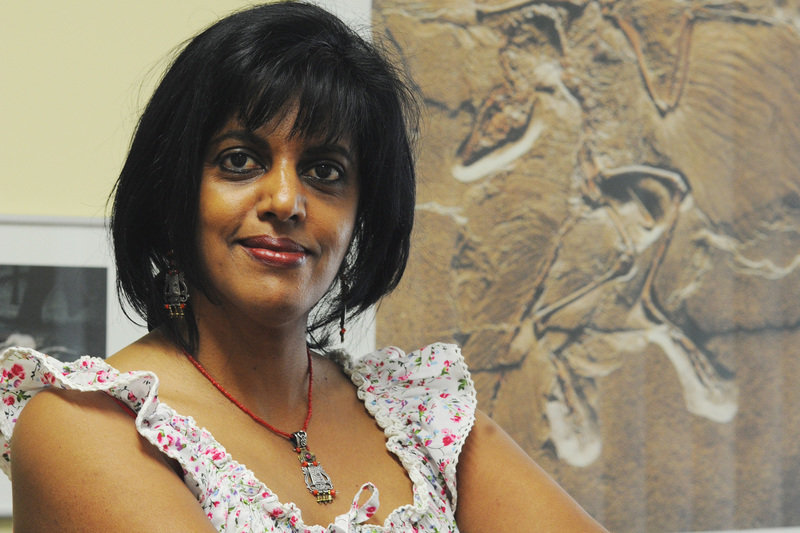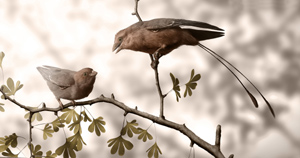New discovery determines gender in fossil birds
28 January 2013 | Story by Newsroom
An international team of palaeontologists led by UCT's Professor Anusuya Chinsamy-Turan (left) has discovered a way to determine the sex of a 125 million-year-old bird species.
Chinsamy-Turan (head of Biological Sciences) conducted the study with Dr Luis Chiappe, director of the Natural History Museum of Los Angeles County's (NHM) Dinosaur Institute; Dr Jesús Marugán-Lobón of Madrid's Universidad Autonóma, Cantoblanco; and Gao Chunling and Zhang Fengjiao of the Dalian Natural History Museum in China.
The discovery is significant, added Chiappe, as it provides the first case of sex identification in an ancient bird. The research paper was published in Nature communications.
Chinsamy-Turan and the team studied hundreds of Confuciusornis fossils unearthed from rocks deposited at the bottom of ancient lakes in northeast China. The birds were studied in China and then samples were sent to Cape Town, where Chinsamy-Turan prepared thin sections of the tiny bones which she then studied under the microscope.
Confuciusornis specimens show remarkable differences in plumage - some had long, almost body-length ornamental tail feathers, others had none - features that have been interpreted as the earliest example of avian courtship. However, the idea that male Confuciusornis birds had ornamental plumage, and females did not, has not been proven until now.
"These are amazingly well-preserved fossils," said Chinsamy-Turan. "Their skeletons and impressions of their feathers are all still beautifully preserved."
In this study, Chinsamy-Turan and the team found undisputed evidence of a gender difference: the presence of medullary bone.

"Just like modern hens, female Confuciusornis birds that lived 125 million years ago formed this special bone inside their long bones and then used it to make the calcium-rich eggshells," she explained. "Finding such tissue - present during a short period of time in reproductively active females - in a specimen that lacked long feathers proved that those birds without ornamental plumage are females.
"This now permits us to assess gender differences in growth and development of this Mesozoic bird."
"When people visit our Dinosaur Hall, they often want to know if the skeletons are male or female. We have nicknames like Sue and Thomas, but of all the thousands of skeletons of dinosaurs or early birds found around the world, only a few have known gender."
But while this discovery offers evidence that both early and modern female avian species were essentially using the same physiological strategy to reproduce, it also spotlights an important difference in when they reached sexual maturity. "Now we know that early birds began reproducing way before they were full grown, a pattern that contrasts with what we know of living birds, which typically begin reproducing after they reach full body size," said Chiappe.
In that way, ancient birds produced offspring like dinosaurs, which also began to reproduce before they were fully grown.
The specimens, housed at the Dalian Natural History Museum in northeast China, had been excavated from rocks formed at the bottom of ancient lakes in a forested environment surrounded by volcanoes. Ancient catastrophes, presumably related to volcanic eruptions, killed large numbers of birds and other animals, whose bodies were buried deep in the lake mud that helped minimize decay and preserving the organs, skeletons, and plumage.
"China has some incredible sites - over the past few years there has been an amazing array of fossil birds and other dinosaur relatives recovered from China," said the UCT palaeobiologist. "It is really a 'hot-spot' for Mesozoic birds! I count myself as incredibly fortunate to have had access to this material."
The study of this fossil material opens an unprecedented window to understand the life-history of these primitive birds," said Marugán-Lobón.
Chinsamy-Turan has worked extensively with dinosaur bones and as dinosaurs are the ancestors of birds, she had a natural link to work on fossil birds. And although she's worked on several Mesozoic birds, Confuciusornis is "really special" because there are so many fossils of the bird which allow scientists to better understand their life history.
"Generally among dinosaurs it's rare to get a representation of different stages of growth. This is even rarer among fossil birds, and we're fortunate to have such a big sample of Confuciusornis specimens that includes juveniles, sub-adults and adults. Now, with this new information, we're also able to assess gender differences."
Unfortunately, there are no modern descendants of Confuciusornis.
In the picture above, a reconstruction of a male and female Confuciusornis bird.
 This work is licensed under a Creative Commons Attribution-NoDerivatives 4.0 International License.
This work is licensed under a Creative Commons Attribution-NoDerivatives 4.0 International License.
Please view the republishing articles page for more information.










